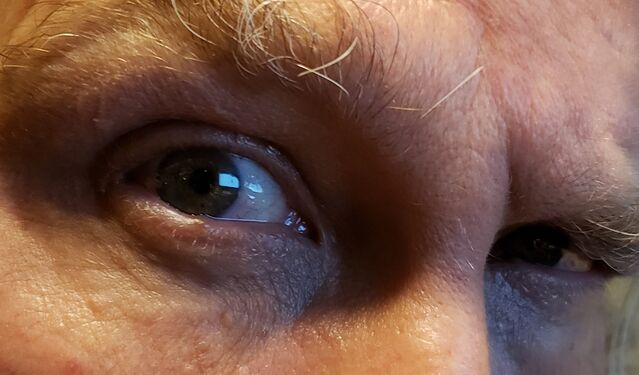Creativity
Situational Awareness: Safety, Creativity, and Truth
Expanding your perception beyond what’s in front of you.
Posted December 14, 2020

Karen and I were heading home after watching a late evening movie at a nearby shopping mall. It was mostly deserted as we waited for the elevator to take us to the underground parking lot. A man wearing a blazer and dress slacks walked up and stood well back from the elevator door. When the door opened, Karen and I got inside and pressed the button for our parking level. The well-dressed man hesitated, then finally entered the elevator as the door was starting to close which caused it to open fully again. He did not press a button to select a floor; in fact he didn’t even look at the buttons to see if we pushed the one for his floor. His hesitation over getting on the elevator, and his not looking at the elevator control panel triggered my Spidey Sense, and I gave him a once-over.
As I scanned him from head to toe, I noticed he was concealing something in his hand. I could see just enough to recognize a knife handle held upside down in his hand and about an inch of the steel blade as the rest was tucked up inside his jacket sleeve. I grabbed Karen’s elbow and leaped, pulling both of us out of the elevator just as the doors were starting to close again. Karen must have seen the look of concern in my eyes because she didn’t resist and as soon as we were away from the elevator she whispered frantically, “What? What did you see?” “That guy had a knife!” I replied. She then suggested we tell security; which we did, but by the time we found a guard the man was long gone.
That happened back in the late 1990s and I didn’t know it at the time, but what I was doing was practicing situational awareness.
Situational Awareness Has Three Stages
Mica Endsley, former Chief Scientist of the United States Air Force, and one of the most recognized experts in situational awareness (SA), defines it in three stages: perception of your environment and its elements; comprehension of the information you've perceived (in your current situation), in other words, analyzing and assessing the elements; and finally projection of how those elements may affect the immediate future and beyond.
In brief, SA is paying attention to what is going on around you and your surroundings, while continuing about your normal activities. It’s about noticing dangers and opportunities.
Terrifying Close-Call Could've Been Avoided
You may have seen the viral YouTube video of a hiker in Utah who came across what he thought were a couple of bobcats on the trail in front of him. But they weren’t bobcats, they were mountain lion cubs, and their mother came out of the brush to defend them. He did a fast backward walk while filming the lion that pursued him about a quarter mile (see video: "Mountain Lion Stalks Me For 6 Minutes!"). His situational awareness may have improved if he’d known the difference between a bobcat and a cougar.
First Determine What Is Normal
Every environment has a baseline, in other words, what normal looks, sounds, smells, and feels like for that locale or setting. When you know the baseline, then you can be on the alert for anomalies. SA is about spotting red flags — recognizing abnormal, unusual, or inconsistent occurrences, behavior or things that don’t belong in that time and place. Don’t ignore the little things.
It can be fun to practice SA when you are walking in a crowd. Try to notice things about the people around you, such as what they are wearing and carrying. What is their emotional state — are they relaxed or nervous? Observe their mannerisms; are they normal, quirky, or aggressive? Make your people-watching purposeful; situational awareness is a mindset that you must intentionally develop. Make it fun, and turn it into a game: When you are out and about, pick certain things to look for such as the exits in a restaurant, and then give yourself points for finding them.
Last year I was in an auto accident. If I had noticed the driver coming up in the lane beside me in my side-view mirror a few seconds earlier, I would’ve seen he was driving too fast. Unfortunately, I didn’t see him until he tried avoiding rear-ending the driver in front of him by cutting in front of me. He overestimated the space in front of me, and both of us ended up in a fender-bender.
Distraction Makes You Vulnerable
Use all of your senses. Is something distracting you from what you should be noticing? Magicians use sleight of hand to distract you from how they do their tricks. Pickpockets use distraction as well by bumping into you or stopping you to ask a question.
Are you distracting yourself? Cell phones and mobile devices take our attention away from our surroundings. Look up from your smartphone. It’s easy to get so caught up in our daily activities and responsibilities that we develop tunnel vision. Make a habit of broadening your field of vision. You don’t want to become so absorbed in what you are doing that you fail to notice potential threats or dangers.
Learn to use your intuition. Oftentimes your subconscious mind will notice subtle signs of danger that your conscious mind will not. Trust your gut.
Don't Make It Easy for Predators
In the movies, we often witness situational awareness being practiced by the guy who always has to sit with his back to the wall. Soldiers have a saying: “Watch your six;” this refers to six o’clock as a position on an analog clock — in other words, watch out for what is behind you. You want to avoid appearing vulnerable in public; walk upright with determination and confidence on your face. Predators prefer to prey on the weak.
SA is about preparation. One way to prepare is to imagine possible scenarios that might occur in a particular setting. The Boy Scout motto, "Be Prepared," really stuck with me. I always carry a pocket knife and a handkerchief. In my car, I have a small toolbox, first aid kit, and fire extinguisher.
Situational Awareness Is Also About Finding Opportunity
I mentioned above that SA is also about noticing opportunities. You may recall from my post "Uncovering the Habits of Innovators," that the primary habit of innovators is to routinely expose themselves to different viewpoints and new stimuli. Creative-thinkers and inventors seek out new information and attempt to experience as many new things as possible. The reason for this is because the more diverse data you have in your brain, then the more material you have for making new connections and combinations. So, while you are out there watching for danger, you may as well look for creative opportunities too.
Once you’ve developed this skill, you will start to notice change early. Dealing with change is frequently a challenge, but if you recognize it soon enough, you can prepare better for it.
Mindful Situational Awareness Includes Questioning the Media
Situational awareness is not just for your physical surroundings. You should extend it to media and the online world. If you read or watch something that makes you angry or frightened, then that is a sign that you need to get more information on that topic. Not just for your safety, but to make certain that you are getting the truth. How often has a news story with heavy coverage, which has little to no effect on your life, distracted you from a story with light coverage which will impact your life? We are living in the era of fake news, indoctrination, and propaganda; it is essential to think critically. For example, I recently came across a fact-check organization that was refuting a story I read. So, I fact-checked the fact-checker and found they are funded by some decidedly biased people which rendered their checking of the facts worthless.

Finally, is situational awareness simply an overreaction to a mostly safe world? I don’t think so, but then there’s this bit of graffiti I found on a bathroom wall: “Just because you’re PARANOID doesn’t mean they are NOT out to get you.”
Robert Evans Wilson, Jr. is an innovation/change speaker, author, and consultant.




